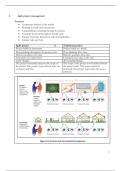Summary
PMP 2024: Summary of the Agile Project Management
This document offers a comprehensive summary of everything you need to know about Agile Project Management. It covers the key characteristics of Agile PM and provides a comparison to Traditional PM. It delves into the four main Agile methods—Scrum, Extreme Programming (XP), Lean Development, and ...
[Show more]



